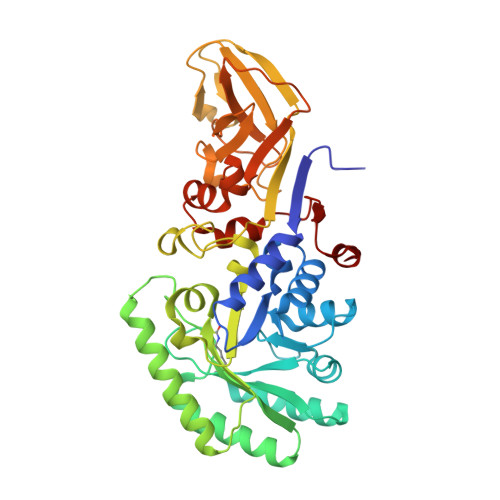Structural evidence that alanine racemase from a D-cycloserine-producing microorganism exhibits resistance to its own product.
Noda, M., Matoba, Y., Kumagai, T., Sugiyama, M.(2004) J Biological Chem 279: 46153-46161
- PubMed: 15302886
- DOI: https://doi.org/10.1074/jbc.M404605200
- Primary Citation of Related Structures:
1VFH, 1VFS, 1VFT - PubMed Abstract:
Alanine racemase (ALR), an enzyme that catalyzes the interconversion of Ala enantiomers, is essential for the synthesis of the bacterial cell wall. We have shown that it is harder to inhibit the catalytic activity of ALR from D-cycloserine (DCS)-producing Streptomyces lavendulae than that from Escherichia coli by DCS. To obtain structural evidence for the fact that Streptomyces ALR displays resistance to DCS, we determined the precise nature of the x-ray crystal structures of the cycloserine-free and cycloserine enantiomer-bound forms of Streptomyces ALR at high resolutions. Streptomyces ALR takes a dimer structure, which is formed by interactions between the N-terminal domain of one monomer with the C-terminal domain of its partner. Each of the two active sites of ALR, which is generated as a result of the formation of the dimer structure, is composed of pyridoxal 5'-phosphate (PLP), the PLP-binding residue Lys(38), and the amino acids in the immediate environment of the pyridoxal cofactor. The current model suggests that each active site of Streptomyces ALR maintains a larger space and takes a more rigid conformation than that of Bacillus stearothermophilus ALR determined previously. Furthermore, we show that Streptomyces ALR results in a slow conversion to a final form of a pyridoxal derivative arising from either isomer of cycloserine, which inhibits the catalytic activity noncompetitively. In fact, the slow conversion is confirmed by the fact that each enzyme bound cycloserine derivative, which is bound to PLP, takes an asymmetric structure.
- Department of Molecular Microbiology and Biotechnology, Graduate School of Biomedical Sciences, Hiroshima University, Kasumi 1-2-3, Minami-Ku, Hiroshima 734-8551, Japan.
Organizational Affiliation:



















